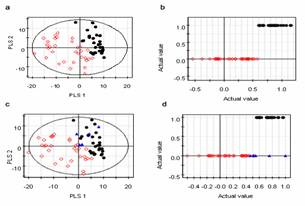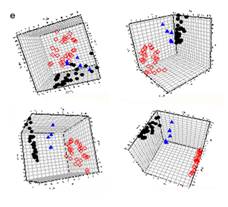ABSTRACT: 3215
1H NMR-Based Metabonomic Analysis for Detection of Oral cancer
| J. ZHOU, B. XU, W. LI, J. HUANG, L. XIAO, J. XUE, J. LU, and X. KONG, State Key Laboratory of Stomatology(Sichuan University), Chengdu, China | |
Objective: To evaluate the feasibility of applying 1H nuclear magnetic resonance (1H-NMR) based metabonomic method to earlier detect the differences in the plasma among the patients with oral squamous cell carcinoma (OSCC), oral leukoplakia (OLK)and the healthy controls. Methods: The human plasma samples used in the 1H-NMR based metabonomic method were obtained from 33OSSC patients, 5OLK patients, and 28healthy controls. The spectral analysis was performed, and the obtained data were analyzed by the unsupervised principal component analysis (PCA) and the partial least squares discriminant analysis (PLS-DA) to find out the difference among the three groups. Results: PLS-DA analyses have revealed a good model to detect the NMR data that can differentiate the OSCC patients from the OLK patients and the controls using a blind test set.
Fig1: The plots showed the result of the two test sets; a and b: the PLS-DA plot in the test set 1; c and d: the PLS-DA plot in the test set 2; (red open diamonds represent OSCC patients; black dots represent healthy controls; blue triangles represent OLK patients).
Fig2: The 3D score plot of the test set 2 dynamically show that the three groups were located in the different spaces. Conclusion: The 1H NMR-based metabonomic method is a feasible and efficient method for differentiating the plasma of OSCC patient from the healthy control. As a potential novel strategy and a more convenient technique, it deserves a further evaluation for an early detection of oral cancer.
| |
| Seq #299 - Oral Cancer, Soft-tissue Lesions, Arterial Plaque 1:45 PM-3:00 PM, Saturday, July 5, 2008 Metro Toronto Convention Centre Exhibit Hall D-E | |
©Copyright 2008 American Association for Dental Research. All Rights Reserved.

